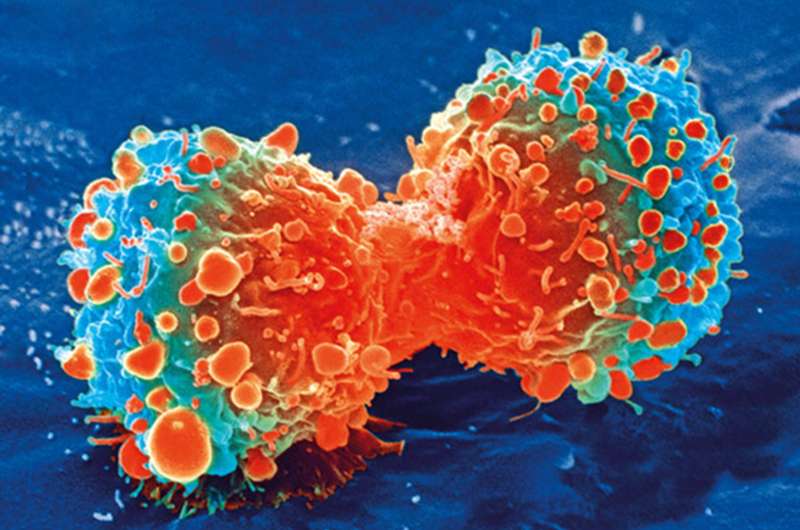Researchers discover cell mechanism that delays and repairs DNA damage that can lead to cancer

Researchers from the University of Copenhagen have identified a specific mechanism that protects cells from natural DNA errors that could permanently damage the genetic code and lead to diseases such as cancer. The study has just been published in one of the most influential scientific journals, Nature Cell Biology.
Researchers from the University of Copenhagen have discovered a mechanism that gives human cells a chance to stop piling up mutations. The discovery could prove to be very useful in the development of new treatments against diseases caused by changes in human DNA such as cancer.
To limit harmful changes in the genetic code that may lead to potential diseases, cells rely on a natural defense mechanism. The new study shows that specialised proteins engulf and protect the damaged DNA and 'escort' it until the damage can be repaired. The researchers discovered that this process relies on precise timing and meticulous control inside the cells.
"We have discovered a specific mechanism in human cells that delays propagation of DNA damage in successive generations of dividing cells. This discovery helps us understand how our bodies protect themselves from many types of cancer," says Professor Jiri Lukas, Head of the Chromosome Stability and Dynamics Group and Executive Director of the Novo Nordisk Foundation Center for Protein Research at the University of Copenhagen.
Defense against an enemy within
Cancer typically develops from cells with damaged DNA. It is well-known that tobacco smoke or ultraviolet light causes lung or skin cancer due to their ability to damage DNA. However bad this may be, the awareness of the origins of these cancers can lead to reduced risk simply by discontinuing smoking or using sunscreen.
Normal cellular processes such as DNA replication comprise a more problematic cause of DNA damage. These processes cannot be avoided because they are inevitable every time cells divide. The scale of this problem is best illustrated by realizing that our bodies are made up by successive divisions of trillions of cells, all originating from a single fertilized egg. Every day, a quarter of a trillion cells in the adult human body continue to divide to replenish old or damaged tissue. Amongst the multitude of DNA damage incurred during each such cell division process, the most dangerous are those that can be passed on from mother cells to newly born daughter cells. This inherited DNA damage is the true 'enemy within' that cannot be simply avoided by lifestyle changes.
Heritable DNA damage as a source of cancer
The new discovery is a result of many years of work and is rooted in the finding made eight years ago by the same group (also published in Nature Cell Biology). In 2011, Jiri Lukas' group found that inherited DNA damage caused by problems during DNA replication is protected in specialised organelles called 53BP1 nuclear bodies.
In the new study, the researchers took advantage of their ability to label the 53BP1 nuclear bodies in living human cells using fluorescent dyes and then followed them under the microscope over several successive generations. This made it possible for the first time to observe the fate of inherited DNA damage directly from the time of generation in mother cells to their expression in daughter cells. It was a true tour-de-force, as tracking living cells under the microscope for many hours, and even days, is a challenging task, which only a few laboratories in the world can do.
The researchers found that daughter cells are well equipped for the challenges of life and mobilise 53BP1 nuclear bodies to 'escort' the inherited DNA lesions to a very late stage of their division cycle when they become competent for one last attempt to repair inherited DNA lesions.
The researchers also found that the key molecular component of this 'repair toolkit' is an enzyme called RAD52, which, as a result of this study, now qualifies as a true member of the tumour suppressor family of proteins that guards DNA against cancer-predisposing mutations.
"53BP1 nuclear bodies delay cell division in daughter cells in order to reach the only remaining time in their lifecycle when they can mend DNA lesions that their mother caused but could not fix. This second chance is vital because it is also the last one. We have predicted and then experimentally documented that a failure of this second chance converts the initially curable DNA damage to one that can no longer be fixed. Accumulation of such mishaps could lead to disease, including cancer," says Assistant Professor Kai John Neelsen of the Novo Nordisk Foundation Center for Protein Research.
This knowledge may prove vital in the improvement of cancer therapy. As many cancer drugs damage the DNA of rapidly dividing cancer cells, understanding the timing and mechanisms for repairing DNA is essential in developing new drugs and minimising the side effects of current treatments.
"Our work reveals unexpected ways in which cells deal with inherited DNA damage. With the identification of the key proteins driving this process, we have laid the foundation for investigations into potential therapeutic applications," says postdoctoral researcher Julian Spies of the Novo Nordisk Foundation Center for Protein Research at the University of Copenhagen.
More information: Julian Spies et al, 53BP1 nuclear bodies enforce replication timing at under-replicated DNA to limit heritable DNA damage, Nature Cell Biology (2019). DOI: 10.1038/s41556-019-0293-6
Journal information: Nature Cell Biology
Provided by University of Copenhagen


















